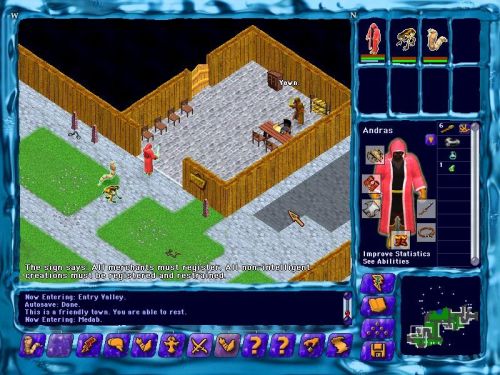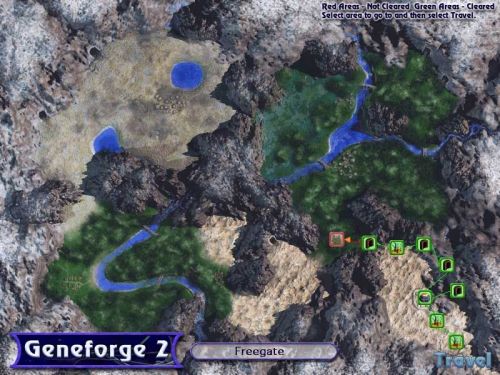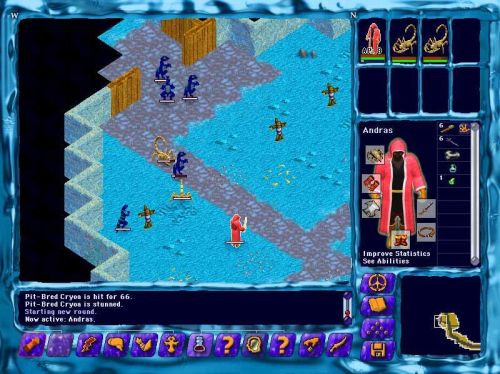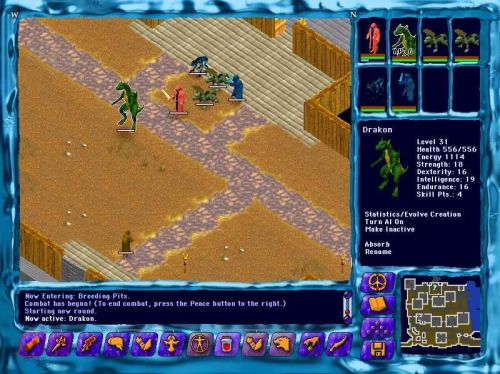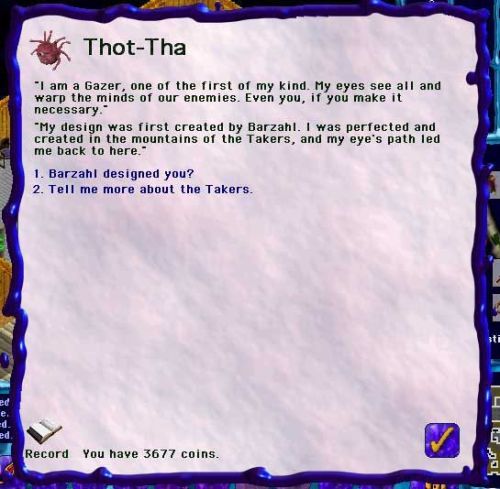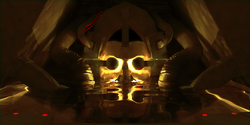Geneforge 2 review: Better Late Than Never
Geneforge 2 review: Better Late Than Never
Codex Review - posted by Spazmo on Thu 19 February 2004, 10:33:38
Tags: Geneforge 2; Jeff Vogel; Spiderweb SoftwareThe Very Definition of Bang for Your Buck
If you ask the staff members of the RPG Codex for their favourite CRPGs, you're likely to find two common answers from all of them: Fallout and Geneforge. The first is something of a no-brainer but many gamers have never heard of the latter, which is a real shame given how good it is. For a mere $25, the good folks at Spiderweb Software would sell you Geneforge, easily one of the best CRPGs in years. Geneforge was a solid success for Spiderweb, prompting the development and release of a sequel, Geneforge 2. We're happy to report that Geneforge 2 is a fantastic game and lives up to its predecessor admirably.
The world of Geneforge revolves around the Shapers. Within the setting of the games, Shapers are powerful wielders of magical energies who use their skills to create life. From raw magical energy, Shapers can bring into existence a wide variety of servants. From the moderately intelligent serviles who handle all menial tasks such as farming and record keeping to the strong, ape-like thahds who serve as troops in the Shaper armies up to the powerful Battle Alphas and Cryodrakes, which are among the most powerful of the combat creations. They even grow batons which fire a variety of projectiles at enemies for ranged combat. Your character was a novice Shaper in the first game who was on the way to a distant island for training when your craft (a living creature itself) was attacked by a ship and your character is forced onto a nearby island. Once there, you investigated the various mysteries of Sucia Island, which was declared Barred by the Shaper Council. Why was it Barred? Why was the island abandoned so quickly? Who were these mysterious foreigners now exploring the island? Over the course of Geneforge, you found the answers to these questions and eventually made it off the island.
The Plot Thickens
The second game takes place not long after the first. You fill the shoes of another novice shaper. This time, you are travelling with your mentor to a small mining village on the borders of Shaper lands called Drypeak. Once you arrive, you see that things are dreadfully wrong. Rogue creations wander the countryside, attacking villagers and serviles, and the mines are also infested with rogues. You discover that one of the founders of the village is missing, having died under mysterious circumstances. You and your teacher are thrown into the middle of this nest of intrigue. It isn't long before your teacher disappears and you are left to uncover the possibly insidious nature of the events taking place at Drypeak for yourself.
Geneforge 2 does indeed sound dramatic and the whole thing is superbly done. One remarkable quality in Jeff Vogel's writing is the sense of mystery he manages to maintain in both Geneforge games. When something secret and probably bad is happening in one of Spiderweb's games, you honestly want to find out what in the heck is going on. Besides that, Geneforge 2 is a mighty big game. There's loads of areas, NPCs, quests and all the other junk you need to make a great big CRPG. The whole game is roughly as big as the first one, but it does have more stuff in it. Geneforge had three major factions you could join--the Awakened, Obeyers and Takers--while the sequel has one more. These factions are roughly the same as in the first game. One group wants to obey Shaper Law and end the insurgency. Another wants to live in peace with the Shapers but not under them. A third is extremely xenophobic and wants to destroy all Shapers in retribution for years of abuse. The player can eventually choose to side with any one of these factions or with none at all. Depending on which faction you choose, some things in the game will get easier and others will be harder. Siding with Zakary may give you access to all the ph4t l3wt in his castle, but the Awakened in Medab will probably be suspicious of you and less willing to share their own goodies.
This brings me to another point about Geneforge 2: your actions have consequences in this game. Each faction hears about the various things you do on the island, the things you say to people and the views you express. If you help a rogue servile escape, for example, people will hear about it. Some, like the Awakened who believe in freedom and equality for the serviles, will think better of you. Others, such as the Shaper community of Drypeak, will frown upon this. NPCs will be more or less willing to hand out quests and information. Merchants will raise or lower their prices. You have to be careful when making decisions not to alienate anyone you might need later, making it that much harder to walk the "free agent" path and not choose a faction at all.
Numbers and Dice
Geneforge 2's character system, which woefully lacks a nifty acronym that the cool crowd can call it by, is much the same as in the first game. The same three classes--Shaper, Agent and Guardian--return in the sequel. The first is a spellcaster who is very skilled at making creations with respectable magical ability to back that up but poor combat abilities. Agents are very weak at shaping but have powerful magic and decent melee combat. Finally, Guardians are your average fighter with a twist: good at hitting fleshy things with metal things, but bad at magic. The twist is that Guardians have some ability at Shaping, which is nice because it's always good to have some backup in a fight. Creations with ranged attacks compliment the melee heavy Guardians especially well.
Largely the same skills from Geneforge also make appearances. There has been some rebalancing of skills but it all works roughly the same. What's new in the ruleset are some goodies for higher level characters. A few new creations have been added to the first game's roster, including elementals. Some flashy high end spells have also been added for the magically inclined.
One neat thing about GF2 is a handy help screen that can be brought up at any time with a hotkey. This screen is effective as an in-game manual. It contains all the information you need about the various skills, classes, spells, creations and other gameplay elements. It's not quite as informative as the hyperlink system in ToEE, which had in-depth information about all rolls and modifiers to them. In fact, there's no way to see your rolls in Geneforge 2 at all or even to know how the rolls work. In my opinion, players with a bent for powergaming would have appreciated disclosure of the mechanics and the rolls of the game so they could tinker with their character and min/max them effectively. Many people say that powergamers shouldn't be indulged, but if that's how some people choose to play a game--a single player one at that--then they should be allowed to do exactly as they please.
In general, there have been very few changes and technical improvements since Geneforge. Some handy interface improvements have been made (most notably, the dismayingly vomit green interface from the first game has been replaced by a more palatable blue) but the game still looks and plays largely the same, which might be a problem for you if you felt the game's dated visuals were too inaccessible the first time around.
Happily, combat in GF2 is turn-based, but it isn't anywhere near as complex as that of titles like Jagged Alliance 2 or Temple of Elemental Evil, but it still works. Animations are kept short and turns aren't very long so everything moves at a very brisk pace. The combat in Geneforge 2 is, however, somewhat over-simplified. There is, of course, a degree of tactics involved in the combat, but that mostly involves not taking on an entire pack of enemies at once and ducking behind cover to draw enemies to you. The real problem here is a lack of options in combat. Most characters--especially Guardians--will find themselves extremely limited in terms of what they can do in combat situations. Most often, the only choice you have to make is to make an attack (with sword, spell or thorn baton) or to use a healing item. We've been spoiled by all the tactical whatnots ToEE offers us and GF2 seems over-simplified in comparison. The game could definitely stand to take a lesson from the aforementioned games and throw a few more gears into the combat mechanic. Simple is always good, but Geneforge 2 goes a bit too far.
That said, the combat comes out all right. It's still challenging and usually not boring, which is good because there's no lack of combat in GF2. There are many areas in the game--wilderness areas, mines, abandoned laboratories, etc.--that are simply full of monsters with the odd NPC or quest sensitive item here and there. You can run away from your enemies (though this usually just leads to an enormous, undefeatable clump of foes somewhere towards the middle of the area), but it is somewhat bothersome to have to trek through literally dozens of areas filled with monsters who attack on sight.
Decisions, Decisions
It's interesting that a game as combat heavy as GF2 also manages to provide such robust role-playing. As noted above, characters can choose to join factions that fundamentally change how the game plays and ends. The game itself is filled with choices like this. The most significant choice made is, of course, which faction (or, if such is your choice, none at all) you choose but Geneforge 2 provides astounding freedom of action throughout the game. You have a great big corner of Shaper lands to explore--do whatever you want to. Almost every quest has multiple ways of being resolved and, in turn, affects people's perceptions of you in different ways. One quest that comes up fairly early in the game is as follows: a farmer living alone with three serviles in a wilderness area (which is, incidentally, replete with thahds, fyoras and other sword fodder) tells you that one of his serviles has run away. He asks you if you'll recover it for him. Eventually, you find the servile in a complex of caves to the south. When you confront him and find that he belongs to the farmer in question, you have four options: do nothing (i.e. decide later), force him to return to his master with your Shaper might of powerful doom, tell him you'll lie to the farmer and say the servile was killed or outright destroy the rebelling servile with your Shaper might of powerful doom. What you choose will either get you in good with the faction that's loyal to the Shapers, the one that wants independence or just with the complete bastards of the world. There's a number of similarly ethically motivated quests throughout the game which all revolve around the same axis: Servile independence. This is the main theme of the game, which it shares with the original Geneforge. Essentially, the question is this: if you create intelligent life, is it right and fair to enslave it? Or should it be treated as an equal? Granted, it's the kind of thing you see in countless Star Trek episodes ("Don't eat that space lobster--it's got an IQ of 437!"), but it's still a compelling question and is certainly more interesting than the old "good vs. evil--which is better?" thing that's usually labelled "ethical question" in CRPGs.
Ultimately, it's all up to you. Do you lead the serviles to independence or back into, well, servility? How do you do it? Geneforge 2 is a game of decisions. The whole area is a powderkeg waiting to blow. How and where will you sever the fuse? Or will you simply ignite the explosion that will shake the whole Shaper world? It's all up to you. Geneforge 2 is nearly unmatched even by games like Fallout in terms of choice. Nope, your eyes do not deceive you, I just said GF2 was better than Fallout in a certain aspect. In the 1997 post-apocalyptic game, you had to defeat the mutants no matter what--the ending where you get dipped and Vault 13 is destroyed doesn't count. There was terrific latitude in terms of how you do it, but you had to do it in the end. GF2 allows you to define your own endgame goal, which is truly remarkable. Many CRPGs have the big plot branching point mere hours before the end of the game, but Geneforge 2 lets you make choices that permanently affect how the game will play for you in the demo, which is a mere sliver of the whole game.
Naturally, this terrific open-endedness (and open-middleness, really, which is the part many developers slip up on) leads to loads of replayability. Beyond the numerous varieties of character builds you can play (a spell-slinging agent's path through the game is drastically different from that of a Shaper with a dozen meat shields), the sheer amount of choices you can make will change how the game ends significantly--maybe that particular faction will survive if I do this or that quest this time around. A single playthrough of this large game already will keep you busy for quite some time, but given that you can go through it several times without getting a feeling of sameness is fantastic.
In Other Words: Buy It
There's a good reason Geneforge 2 was just about the only good thing mentioned in my recent Year in Review feature. It is easily the best CRPG of 2003, bar none. No other title this year has been as globally good as GF2. Temple of Elemental Evil had better combat and Knights of the Old Republic had better production values but neither ToEE or KotOR can match Geneforge 2's overall quality. And given how cheap it is--you can download a free demo from Spiderweb and registration only costs $25--you have no excuse not to buy Geneforge 2 if you haven't already.
Geneforge 2 is the last game that will use the engine that first appeared in Spiderweb's Nethergate. I personally can't wait to see what's next from Jeff Vogel and Spiderweb's new engine. If it's anywhere near as good as the Geneforge games have been (and maybe a science fiction game for a change, Mr. Vogel), I'll be all over it.
There are 11 comments on Geneforge 2 review: Better Late Than Never




